Themed collection The Chemistry of Thermoelectric Materials

Themed issue on the chemistry of thermoelectric materials
Guest editor G. Jeffrey Snyder introduces this Journal of Materials Chemistry C themed issue on the chemistry of thermoelectric materials.
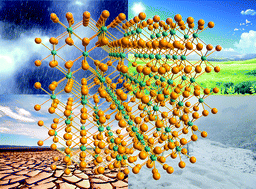
J. Mater. Chem. C, 2015,3, 10332-10335
https://doi.org/10.1039/C5TC90161H
Flexible thermoelectric materials and device optimization for wearable energy harvesting
In this paper, we review recent advances in the development of flexible thermoelectric materials and devices for wearable human body-heat energy harvesting applications.

J. Mater. Chem. C, 2015,3, 10362-10374
https://doi.org/10.1039/C5TC01644D
Tetrahedrites as thermoelectric materials: an overview
This review discusses about the crystal structure, chemical bonding, and the electronic band structure of tetrahedrite materials. Also, this review outlines the effect of different doping elements on the thermoelectric properties of tetrahedrite materials.

J. Mater. Chem. C, 2015,3, 12364-12378
https://doi.org/10.1039/C5TC02537K
Silicon de novo: energy filtering and enhanced thermoelectric performances of nanocrystalline silicon and silicon alloys
Energy filtering due to second-phase precipitation in nanocrystalline silicon may lead to remarkable improvements of its thermoelectric power factor.
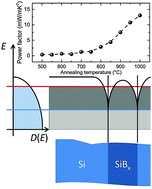
J. Mater. Chem. C, 2015,3, 12176-12185
https://doi.org/10.1039/C5TC01632K
Bismuth nanowire thermoelectrics
Here, we review the current progress in the thermoelectrics of bismuth nanowires, the fundamentals of their advantage and limitation over bulk Bi, and their potential use for enhancing thermoelectric performance.
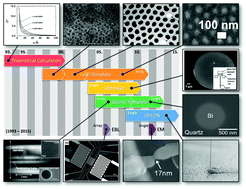
J. Mater. Chem. C, 2015,3, 11999-12013
https://doi.org/10.1039/C5TC02886H
Strong correlation between the crystal structure and the thermoelectric properties of pavonite homologue Cux+yBi5−yCh8 (Ch = S or Se) compounds
Strong correlation between interstitial sites and thermoelectric properties of pavonite homologue Cux+yBi5−yCh8 (Ch = S or Se) compounds.
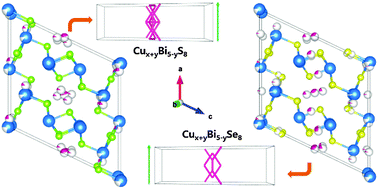
J. Mater. Chem. C, 2015,3, 11271-11285
https://doi.org/10.1039/C5TC02388B
Inorganic–organic superlattice thin films for thermoelectrics
Nanoscale layer-engineering using the combined atomic/molecular layer deposition (ALD/MLD) technique for the fabrication of oxide–organic thin-film superlattices is an attractive way to tailor the performance of thermoelectric materials as it potentially allows us to suppress thermal conductivity without significantly hindering the electrical transport properties.
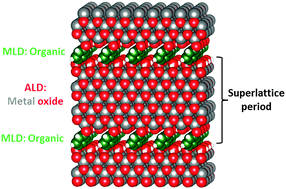
J. Mater. Chem. C, 2015,3, 10349-10361
https://doi.org/10.1039/C5TC01643F
Strategies for engineering phonon transport in thermoelectrics
We discuss representative strategies of phonon engineering by categorizing them into the methods affecting each component of thermal conductivity.
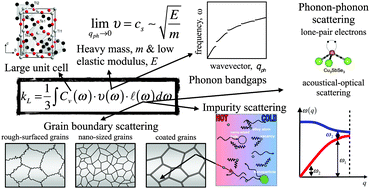
J. Mater. Chem. C, 2015,3, 10336-10348
https://doi.org/10.1039/C5TC01670C
Record figure of merit values of highly stoichiometric Sb2Te3 porous bulk synthesized from tailor-made molecular precursors in ionic liquids
We report on the synthesis of Sb2Te3 nanoparticles with zT values of up to 1.5. The thermoelectric transport parameters were independently optimized, giving guidance for the design of thermoelectric materials.
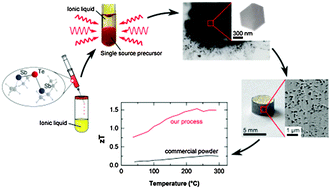
J. Mater. Chem. C, 2015,3, 10375-10380
https://doi.org/10.1039/C5TC01248A
Understanding thermoelectric properties from high-throughput calculations: trends, insights, and comparisons with experiment
An overview of computed thermoelectric properties for more than 48 000 inorganic compounds from the Materials Project (MP).
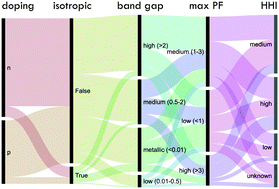
J. Mater. Chem. C, 2016,4, 4414-4426
https://doi.org/10.1039/C5TC04339E
Crystal structure and thermoelectric properties of Sr–Mo substituted CaMnO3: a combined experimental and computational study
Experimental and modelling investigation of Sr/Mo (co-)doped CaMnO3 highlighted the role of Mn3+ and presence of domain boundaries in thermal transport and thermoelectric properties.

J. Mater. Chem. C, 2015,3, 12245-12259
https://doi.org/10.1039/C5TC02318A
Thermoelectric properties of materials with nontrivial electronic topology
Small band gap topological insulators and Weyl semimetals show excellent TE properties. We identify two mechanisms (i) asymmetry in the electronic density of states caused by band inversion at an electronic topological transition and (ii) band convergence as the key to good TE behavior of these materials.

J. Mater. Chem. C, 2015,3, 12130-12139
https://doi.org/10.1039/C5TC02344K
Morphological effects on the thermoelectric properties of Ti0.3Zr0.35Hf0.35Ni1+δSn alloys following phase separation
Thermoelectrics are known as one of the emerging renewable power generation technologies.
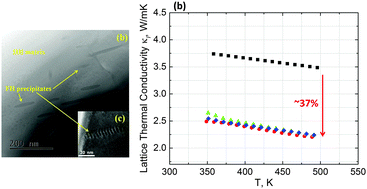
J. Mater. Chem. C, 2015,3, 11653-11659
https://doi.org/10.1039/C5TC03214H
Determining dilute-limit solvus boundaries in multi-component systems using defect energetics: Na in PbTe and PbS
Defect calculations have untapped potential to quantitatively determine thermodynamics of semiconductors. We present a methodology to determine solve boundaries in multicomponent systems using defect energy calculations.
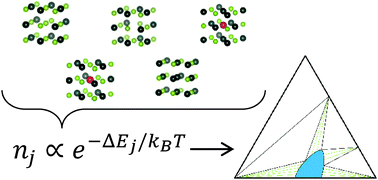
J. Mater. Chem. C, 2015,3, 10630-10649
https://doi.org/10.1039/C5TC02252E
Acido-basic control of the thermoelectric properties of poly(3,4-ethylenedioxythiophene)tosylate (PEDOT-Tos) thin films
PEDOT-Tos is one of the conducting polymers that displays the most promising thermoelectric properties.

J. Mater. Chem. C, 2015,3, 10616-10623
https://doi.org/10.1039/C5TC01952D
Enhanced thermoelectric performance of n-type Cu0.008Bi2Te2.7Se0.3 by band engineering
We herein report the significantly improved thermoelectric performance of n-type Bi2Te2.7Se0.3 polycrystalline bulks through band structure engineering achieved by Au-doping.

J. Mater. Chem. C, 2015,3, 10604-10609
https://doi.org/10.1039/C5TC01731A
Fabrication of thermoelectric materials – thermal stability and repeatability of achieved efficiencies
Thermoelectric properties of metastable metal chalcogenides degrade with thermal cycling.
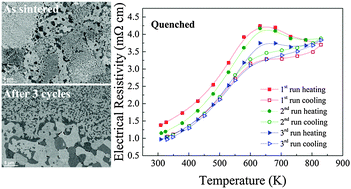
J. Mater. Chem. C, 2015,3, 10610-10615
https://doi.org/10.1039/C5TC02210J
Ball milling as an effective route for the preparation of doped bornite: synthesis, stability and thermoelectric properties
Ball milling has been exploited for the preparation of Cu5Fe1−xMnxS4. These materials, which are p-type semiconductors, exhibit a figure of merit greater than 0.5 at moderate temperatures.

J. Mater. Chem. C, 2015,3, 10624-10629
https://doi.org/10.1039/C5TC01704A
High performance n-type bismuth telluride based alloys for mid-temperature power generation
We combine Se alloying, SbI3 doping and repeated hot deformation to obtain high-performance n-type Bi2Te3 based mid-temperature thermoelectric materials for power generation.
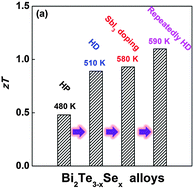
J. Mater. Chem. C, 2015,3, 10597-10603
https://doi.org/10.1039/C5TC02263K
Electrical and thermal transport properties of spark plasma sintered n-type Bi2Te3−xSex alloys: the combined effect of point defect and Se content
Investigation of electrical and thermal transport properties in powder-processed Bi2Te3−xSex thermoelectric alloys determined the optimal composition based on defect chemistry.
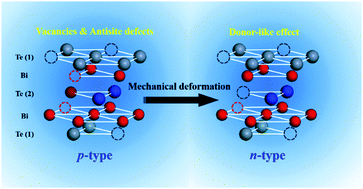
J. Mater. Chem. C, 2015,3, 10583-10589
https://doi.org/10.1039/C5TC02219C
Computational and experimental investigation of TmAgTe2 and XYZ2 compounds, a new group of thermoelectric materials identified by first-principles high-throughput screening
Promising thermoelectric materials (XYZ2) with high band degeneracy and low thermal conductivity.
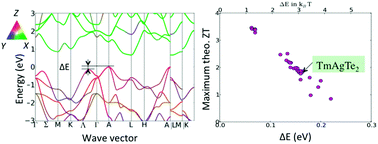
J. Mater. Chem. C, 2015,3, 10554-10565
https://doi.org/10.1039/C5TC01440A
Interfacial reactions between PbTe-based thermoelectric materials and Cu and Ag bonding materials
The development of reliable bonding materials for PbTe-based thermoelectric modules that can undergo long-term operations at high temperature is carried out.
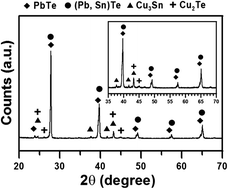
J. Mater. Chem. C, 2015,3, 10590-10596
https://doi.org/10.1039/C5TC01662B
Compositions and thermoelectric properties of XNiSn (X = Ti, Zr, Hf) half-Heusler alloys
Neutron powder diffraction has been used to investigate the experimental compositions of single and multiphase half-Heusler samples.
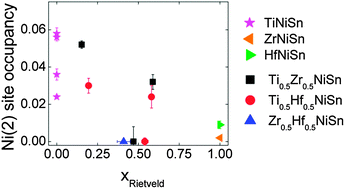
J. Mater. Chem. C, 2015,3, 10534-10542
https://doi.org/10.1039/C5TC02025E
High thermoelectric figure-of-merit in Sb2Te3/Ag2Te bulk composites as Pb-free p-type thermoelectric materials
Sb2Te3/Ag2Te (ST/AT) composites with ST/AT molar ratios of 1/1, 2/1, 4/1, 8/1, 16/1, and 32/1 were synthesized, and high ZT values were achieved compared with other Pb-free p-type chalcogenide thermoelectric materials.
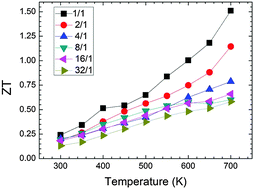
J. Mater. Chem. C, 2015,3, 10494-10499
https://doi.org/10.1039/C5TC01623A
Comparison of local distortions in Ba8Ga16X30 (X = Si, Ge, Sn): an EXAFS study
We report an extended X-ray fine structure (EXAFS) analysis of the type-I clathrates Ba8Ga16X30 (X = Si, Sn) and compare the results with the results of previous studies on X = Ge. The environment about Ba is the most disordered for X=Sn.

J. Mater. Chem. C, 2015,3, 10574-10582
https://doi.org/10.1039/C5TC01641J
Fast direct synthesis and compaction of phase pure thermoelectric ZnSb
ZnSb is a promising low cost, non-toxic thermoelectric material, but large scale applications require development of fast and easy synthesis methods.
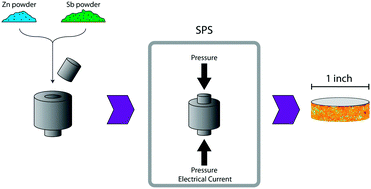
J. Mater. Chem. C, 2015,3, 10543-10553
https://doi.org/10.1039/C5TC01611H
Enhanced average thermoelectric figure of merit of n-type PbTe1−xIx–MgTe
The average thermoelectric figure of merit ZT of n-type PbTe1−xIx–MgTe is successfully enhanced through nano and meso structuring.

J. Mater. Chem. C, 2015,3, 10401-10408
https://doi.org/10.1039/C5TC01652E
The effect of light rare earth element substitution in Yb14MnSb11 on thermoelectric properties
The zT of Yb14MnSb11 is improved by the introduction of a light rare earth element, RE3+ (RE = Pr, Sm) with partially filled f-levels. The carrier concentration is reduced upon substituting RE3+ for Yb2+, adding one electron to the system and improving the zT values 30–40% over that of the pristine material.
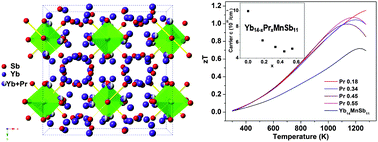
J. Mater. Chem. C, 2015,3, 10566-10573
https://doi.org/10.1039/C5TC02326B
Heterostructures of skutterudites and germanium antimony tellurides – structure analysis and thermoelectric properties of bulk samples
The precipitation of skutterudite-type crystallites in germanium antimony tellurides yields intriguing materials with respect to their thermoelectric performance, especially due to a very low phononic part of the lattice thermal conductivity.

J. Mater. Chem. C, 2015,3, 10525-10533
https://doi.org/10.1039/C5TC01509J
High temperature thermoelectric properties of Zn-doped Eu5In2Sb6
The Zintl phase Eu5In2−xZnxSb6 (x = 0, 0.025, 0.05, 0.1, 0.2) with optimized p-type carrier concentration displays a zT of up to 0.4 at ∼660 K.
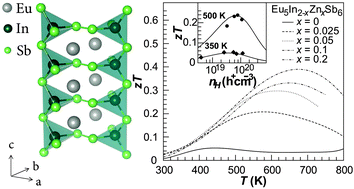
J. Mater. Chem. C, 2015,3, 10518-10524
https://doi.org/10.1039/C5TC01645B
Mechanochemical synthesis and high temperature thermoelectric properties of calcium-doped lanthanum telluride La3−xCaxTe4
The thermoelectric properties from 300–1275 K of calcium-doped La3−xTe4 are reported.

J. Mater. Chem. C, 2015,3, 10459-10466
https://doi.org/10.1039/C5TC01648G
Non-stoichiometric compositions arising from synergistic electronic and size effects. Synthesis, crystal chemistry and electronic properties of A14Cd1+xPn11 compounds (0 ≤ x ≤ 0.3; A = Sr, Eu; Pn = As, Sb)
Synthesis and structural characterization of four compounds, isostructural, but not isoelectronic, with the thermoelectric material Yb14MnSb11.
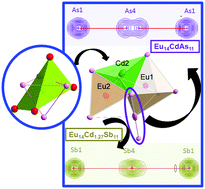
J. Mater. Chem. C, 2015,3, 10388-10400
https://doi.org/10.1039/C5TC01605C
Enhanced thermoelectric power factor of Re-substituted higher manganese silicides with small islands of MnSi secondary phase
A rhenium-substituted HMS sample with small islands of MnSi secondary phase has been prepared by the quenching method. Such unique microstructure leads to an enhanced thermoelectric power factor (PF) as compared to the samples prepared by other methods.
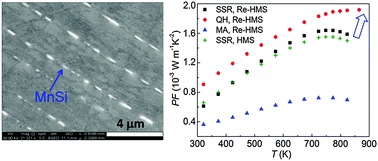
J. Mater. Chem. C, 2015,3, 10500-10508
https://doi.org/10.1039/C5TC01536G
The solid solution series Tl(V1−xCrx)5Se8: crystal structure, magnetic and thermoelectric properties
The crystal structure of single crystalline members of the solid solution series Tl(V1−xCrx)5Se8 (x = 0–1 and Δx = 0.2) was determined and the magnetic and thermoelectric properties of bulk TlV5Se8 were investigated.

J. Mater. Chem. C, 2015,3, 10509-10517
https://doi.org/10.1039/C5TC01766A
Self-assisted nucleation and growth of [010]-oriented Sb2Se3 whiskers: the crystal structure and thermoelectric properties
The thermoelectric power factor of the self-assisted [010]-oriented Sb2Se3 is 104 times higher than that of Sb2Se3 bulk and is comparable to that of Sb2Se3 nanotubes, respectively.
![Graphical abstract: Self-assisted nucleation and growth of [010]-oriented Sb2Se3 whiskers: the crystal structure and thermoelectric properties](/en/Image/Get?imageInfo.ImageType=GA&imageInfo.ImageIdentifier.ManuscriptID=C5TC01364J&imageInfo.ImageIdentifier.Year=2015)
J. Mater. Chem. C, 2015,3, 10488-10493
https://doi.org/10.1039/C5TC01364J
Crystal structure, electronic band structure and high-temperature thermoelectric properties of Te-substituted tetrahedrites Cu12Sb4−xTexS13 (0.5 ≤ x ≤ 2.0)
The crystal structure, thermal stability and high-temperature thermoelectric properties of two series of tetrahedrites prepared by different synthesis routes are reported underlining the importance of off-stoichiometry in this family of compounds.

J. Mater. Chem. C, 2015,3, 10476-10487
https://doi.org/10.1039/C5TC01636C
Carrier dilution in TiSe2 based intergrowth compounds for enhanced thermoelectric performance
Synthesis and electrical properties of kinetically stabilized (PbSe)1+δ(TiSe2)n thin-film intergrowths are reported for 1 ≤ n ≤ 18. The carriers donated to the TiSe2 from PbSe are diluted with increasing n, leading to a systematic increase in the Seebeck coefficient and thermoelectric power factor.
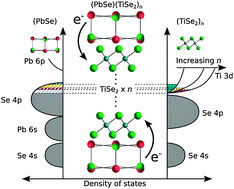
J. Mater. Chem. C, 2015,3, 10451-10458
https://doi.org/10.1039/C5TC01570G
Synthesis, crystal structure, and transport properties of quaternary tetrahedral chalcogenides
The synthesis, crystal structure, and transport properties of quaternary tetrahedral chalcogenides Cu2.1Fe0.9SnSe4, Cu2.2Fe0.8SnSe4 and Cu2.2Zn0.2Fe0.6SnSe4 were investigated. Cu2.2Fe0.8SnSe4 has a ZT value of 0.45 at 750 K, the highest ZT thus far reported at this temperature for solid–solution compositions in this material system.

J. Mater. Chem. C, 2015,3, 10436-10441
https://doi.org/10.1039/C5TC01606A
Thermoelectric transport and microstructure of optimized Mg2Si0.8Sn0.2
We have optimized the thermoelectric material Mg2Si0.8Sn0.2 and analyzed the electronic transport employing a single parabolic band model.

J. Mater. Chem. C, 2015,3, 10467-10475
https://doi.org/10.1039/C5TC01535A
MoSi2-type narrow band gap intermetallic compound Al6Re5Si4 as a thermoelectric material
The thermoelectric properties of MoSi2-type intermetallic compound Al6Re5Si4 (investigated compositions: Al6−xRe4.7Si4+x (x = 0–0.9)) related to TiSi2-type narrow band gap intermetallic compounds were systematically investigated.
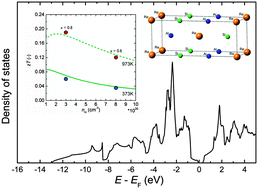
J. Mater. Chem. C, 2015,3, 10422-10429
https://doi.org/10.1039/C5TC01608H
The effect of nickel doping on electron and phonon transport in the n-type nanostructured thermoelectric material CoSbS
The optimized carrier concentration, high effective mass and strong electron–phonon scattering for Ni doped CoSbS contribute to the enhanced ZT value.

J. Mater. Chem. C, 2015,3, 10442-10450
https://doi.org/10.1039/C5TC01560J
Fine tuning of thermoelectric performance in phase-separated half-Heusler compounds
An efficiently designed microstructure leads to a record ZT value in p-type half-Heusler compounds.

J. Mater. Chem. C, 2015,3, 10409-10414
https://doi.org/10.1039/C5TC01196E
Thermal stability of Mg2Si0.3Sn0.7 under different heat treatment conditions
Thermal stability of Sb-doped Mg2Si0.3Sn0.7 was studied by changing the heat treatment conditions (atmosphere, coating, temperature, and time).

J. Mater. Chem. C, 2015,3, 10381-10387
https://doi.org/10.1039/C5TC01434D
Ruthenium oxide as a thermoelectric material: unconventional thermoelectric properties of Li2RuO3
Ruthenium oxides are typical strongly correlated electron systems, where various ordering phenomena occur through delicate interplay among the charge, spin and orbital degrees of freedom.
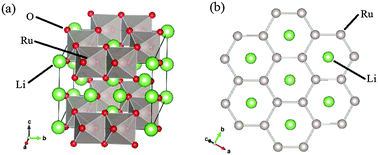
J. Mater. Chem. C, 2015,3, 10430-10435
https://doi.org/10.1039/C5TC01619C
Sb deficiencies control hole transport and boost the thermoelectric performance of p-type AgSbSe2
We demonstrate a new strategy to control the carrier transport in AgSbSe2 by introducing Sb deficiencies. Enhanced electrical conductivity and ultra-low thermal conductivity resulted a peak ZT value ∼1 at 610 K in Sb deficient AgSbSe2.
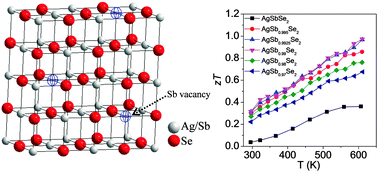
J. Mater. Chem. C, 2015,3, 10415-10421
https://doi.org/10.1039/C5TC01429H
About this collection
Thermoelectrics are gaining increasing interests due to their important potential applications. Many novel thermoelectric materials have been developed by manipulating the doping, electronic structure, phonon structure and scattering, as well as microstructure. Chemistry affects all of these enabling, for example, the tuning and engineering of the electron band structure or phonon scattering. This collection broadly covers the chemistry aspects of thermoelectric materials including their synthesis and processing, chemical and microstructure characterization, transport measurements and theory and modelling of their physical properties.